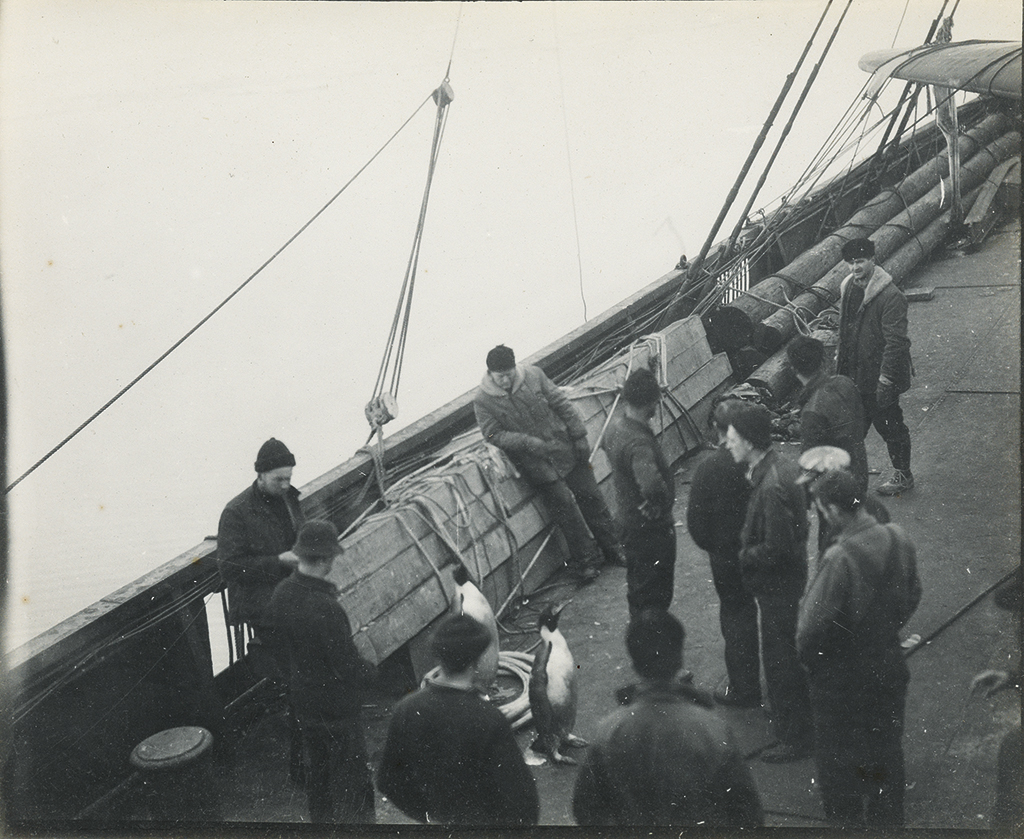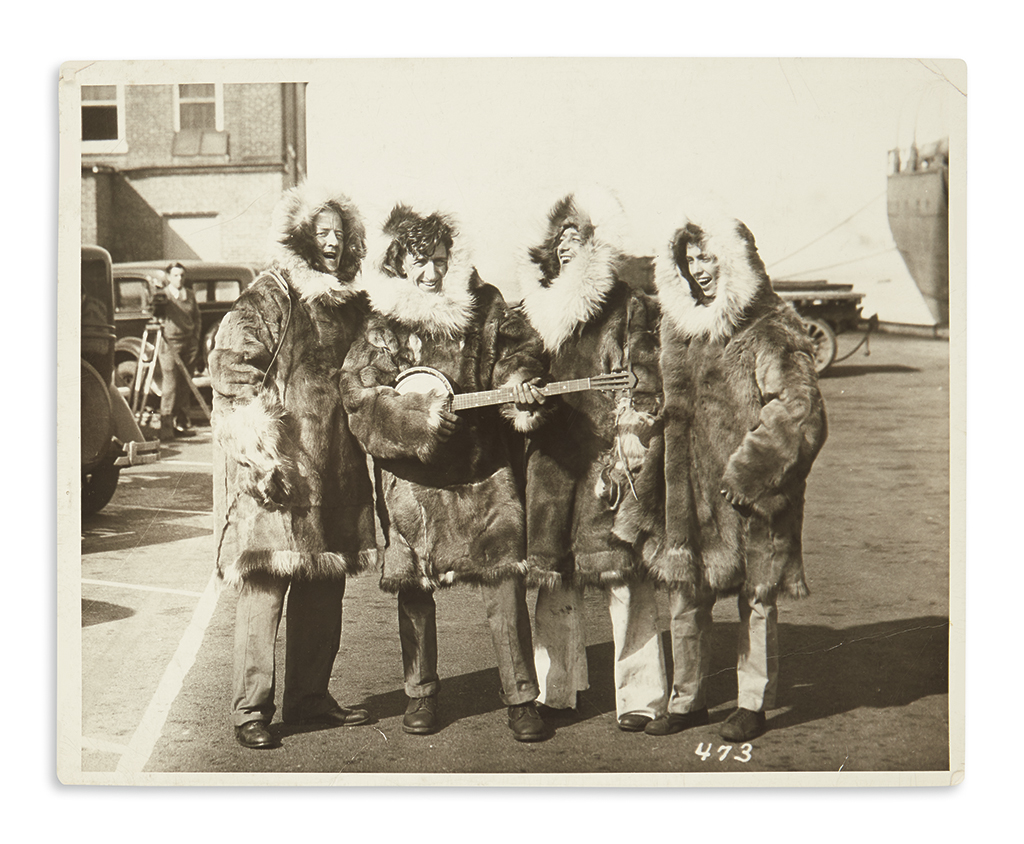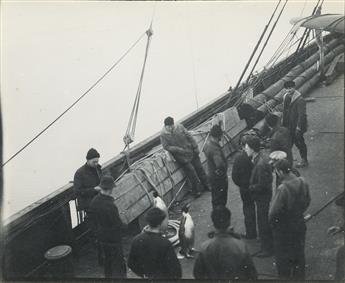Sale 2473 - Lot 34
Price Realized: $ 2,400
Price Realized: $ 3,000
?Final Price Realized includes Buyer’s Premium added to Hammer Price
Estimate: $ 2,000 - $ 3,000
(ANTARCTICA.) Archive of photographs, letters, and telegrams relating to Byrd's second Antarctica expedition. 89 items (0.2 linear feet) in one box: 15 letters and telegrams from expedition members (all in original envelopes), 54 photographs of various sizes, 18 negatives, one canceled postal cover (all from the 1933-35 expedition), and a shaving kit from the 1928 expedition; condition generally strong. Vp, 1928 and 1933-35
Additional Details
Three years after the conclusion of Admiral Richard E. Byrd's successful expedition to Antarctica, he raised enough private funding for a second expedition. His two ships left the United States in the fall of 1933 and returned in early 1935. The expedition marked the first radio broadcast from the frozen continent, and the first effective use of a tractor.
While en route to Antarctica, several members of the expedition stayed at the Seamen's House run by the YMCA and the American Seamen's Friend Society at 550 West 20th Street in Manhattan. Two of them became friendly with William Bachman Carpenter (born 1904), a manager at the facility, and kept him posted with letters and photographs from the expedition (the collection is consigned by a family member). Leland L. Barter wrote two long letters from Boston in July 1933 as the expedition prepared for departure. He served as the ship's engineer on the expedition; a prominent rock outcropping was later named Barter's Bluff in his honor. In these letters, Barter boasts that "this is apt to be a larger and finer expedition than the other one. Money is hard to raise as yet, but Byrd always manages to pull through." Plans to breed dogs and utilize abandoned airplanes from the last trip are discussed. Carpenter's other correspondent was Alfred B. "Hump" Creagh, a crewman and cook on the expedition. He sent 13 radiograms and telegrams from the expedition dated October 1933 to June 1934 (the heart of the Antarctic winter). Most are quite brief, but a long radiogram dated 5 February 1934 offers some compelling narrative: "We are now passing what is commonly known below the Antarctic Circle as the Devil's Graveyard. There are 9,999 icebergs all around us looking like tombstones. The Admiral has made two or three wonderful flights during the last couple of weeks. For the last month, since we left New Zealand, we have been below the Antarctic Circle in waters that have never been seen before by man at any time. . . . It sure is good to hear from the outside world when a man is in a God-forsaken hole like this."
The lot also includes photographs. Hump Creagh sent three larger-format pictures of himself (up to 8 x 10 inches). One (apparently taken in port before heading southward) is of four men in fur-lined expedition gear singing and playing banjo, titled "Quartet in Furs." Almost all of the 51 smaller photographs (most about 3 1/2 x 2 1/2 inches, a few larger) were apparently taken in or near Antarctica. 33 of them bear manuscript captions on verso. Two shows dog drivers Olin Stancliff and Tom Buckley at work; another shows "the first view of Little America since 1930." Both ships are documented, as are numerous penguins, icebergs, and seals. The expedition's seaplane is shown on the open water: "Curtis Condor given by Horlick's Malted Milk, first flight." Another shows chief pilot Harold June unloading gasoline. The monument to Captain Scott is also shown. Two other unusual artifacts accompany the collection: an unaddressed official expedition postal cover canceled from the ship on 17 June 1935, and marked "Last cancellation at ship's post office"; and a 4-piece Gillette shaving kit in its original silk-lined case gilt-stamped "Byrd Antarctic Expedition 1928" (Byrd's first expedition).
While en route to Antarctica, several members of the expedition stayed at the Seamen's House run by the YMCA and the American Seamen's Friend Society at 550 West 20th Street in Manhattan. Two of them became friendly with William Bachman Carpenter (born 1904), a manager at the facility, and kept him posted with letters and photographs from the expedition (the collection is consigned by a family member). Leland L. Barter wrote two long letters from Boston in July 1933 as the expedition prepared for departure. He served as the ship's engineer on the expedition; a prominent rock outcropping was later named Barter's Bluff in his honor. In these letters, Barter boasts that "this is apt to be a larger and finer expedition than the other one. Money is hard to raise as yet, but Byrd always manages to pull through." Plans to breed dogs and utilize abandoned airplanes from the last trip are discussed. Carpenter's other correspondent was Alfred B. "Hump" Creagh, a crewman and cook on the expedition. He sent 13 radiograms and telegrams from the expedition dated October 1933 to June 1934 (the heart of the Antarctic winter). Most are quite brief, but a long radiogram dated 5 February 1934 offers some compelling narrative: "We are now passing what is commonly known below the Antarctic Circle as the Devil's Graveyard. There are 9,999 icebergs all around us looking like tombstones. The Admiral has made two or three wonderful flights during the last couple of weeks. For the last month, since we left New Zealand, we have been below the Antarctic Circle in waters that have never been seen before by man at any time. . . . It sure is good to hear from the outside world when a man is in a God-forsaken hole like this."
The lot also includes photographs. Hump Creagh sent three larger-format pictures of himself (up to 8 x 10 inches). One (apparently taken in port before heading southward) is of four men in fur-lined expedition gear singing and playing banjo, titled "Quartet in Furs." Almost all of the 51 smaller photographs (most about 3 1/2 x 2 1/2 inches, a few larger) were apparently taken in or near Antarctica. 33 of them bear manuscript captions on verso. Two shows dog drivers Olin Stancliff and Tom Buckley at work; another shows "the first view of Little America since 1930." Both ships are documented, as are numerous penguins, icebergs, and seals. The expedition's seaplane is shown on the open water: "Curtis Condor given by Horlick's Malted Milk, first flight." Another shows chief pilot Harold June unloading gasoline. The monument to Captain Scott is also shown. Two other unusual artifacts accompany the collection: an unaddressed official expedition postal cover canceled from the ship on 17 June 1935, and marked "Last cancellation at ship's post office"; and a 4-piece Gillette shaving kit in its original silk-lined case gilt-stamped "Byrd Antarctic Expedition 1928" (Byrd's first expedition).
Exhibition Hours
Exhibition Hours
Aliquam vulputate ornare congue. Vestibulum maximus, libero in placerat faucibus, risus nisl molestie massa, ut maximus metus lectus vel lorem.






